by Devon Ronald Dublin, Emmanuel P. Crucio, Richard Phillips, Suruchi Singh and Jaranporn Lertsahakal
Introduction
Urbanization is increasing and over the next 30 years, two-thirds of the world’s population will be living in urban areas. One of the key drivers for urbanization is economic, as people move to cities for work. This has led to a rapid geographical expansion of urban settlements. For example by 2035 all developing regions, most notably Asia and Africa, will be more urban than rural (State of the world cities, 2007).
The United Nations Conference on Environment and Development (UNCED) in 1992 brought to fore the importance for sustainable development indicators (SDIs) as a tool to assess progress towards sustainability. Agenda 21, one of the outcomes of this conference, asks governments to integrate sustainable development into three national strategies (plans, policies and procedures) and highlights the importance of involving non-governmental organizations (NGOs) and the public in the process. It provides a framework to encourage citizens to create a more sustainable society. Agenda 21 addresses the development of societies and economies by focusing on the conservation and preservation of our environments and natural resources and eradicating poverty. This aspiration is in line with government policies of implementing sustainable development strategies as stipulated in the Habitat Agenda of The Rio Declaration. Nations that have pledged to take part in Agenda 21 are monitored by the Commission on Sustainable Development and are encouraged to implement Agenda 21 at regional and local levels. Malaysia, along with 177 countries attended the UNCED, also known as Rio 92 and adopted the Rio Declaration that gave birth to the Agenda 21, also supporting the strengthening of the UN Human Settlements Programme.
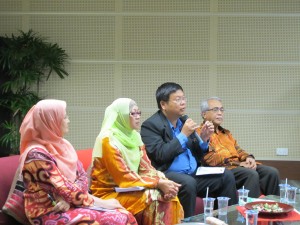 The 2014 ProSPER.Net Leadership Programme brought together participants from different countries and backgrounds to discuss sustainability issues and how to implement programmes to support sustainable practices. The programme included visiting development initiatives in urban localities of Kuala Lumpur and Putrajaya. Participants experienced Malaysia’s attempts to address challenges related to urban sustainability. In this regard, participants identified how Malaysian authorities addressed the need to promote cities that are environmentally sustainable, socially inclusive, economically productive and resilient. The ministry of housing and local government is the lead agency coordinating activities related to human settlements. The ministry also works with other government agencies, the private sector and NGOs. Programmes for human settlements are meant to reflect the needs of the local community, taking into account all aspects of fundamental freedoms, including the right to development, with full respect for various religious and ethical values, cultural backgrounds, philosophical convictions of individuals, and their respective communities.
The 2014 ProSPER.Net Leadership Programme brought together participants from different countries and backgrounds to discuss sustainability issues and how to implement programmes to support sustainable practices. The programme included visiting development initiatives in urban localities of Kuala Lumpur and Putrajaya. Participants experienced Malaysia’s attempts to address challenges related to urban sustainability. In this regard, participants identified how Malaysian authorities addressed the need to promote cities that are environmentally sustainable, socially inclusive, economically productive and resilient. The ministry of housing and local government is the lead agency coordinating activities related to human settlements. The ministry also works with other government agencies, the private sector and NGOs. Programmes for human settlements are meant to reflect the needs of the local community, taking into account all aspects of fundamental freedoms, including the right to development, with full respect for various religious and ethical values, cultural backgrounds, philosophical convictions of individuals, and their respective communities.
Current state
Several official documents inform Malaysia’s social, political and economic development. Written in 1991, Wawasan or Vision 2020, for example, envisions Malaysia as a fully developed country economically, socially, politically and spiritually by 2020. A key part of Vision 2020 is Kuala Lumpur, Malaysia’s premier city that would play an active role. The visions and goals for Kuala Lumpur have been formulated with the aim of creating a sustainable city. The city council has attempted to balance between the competing goals of physical, social and environmental development.
The Tenth Malaysian plan (2011-2015) addresses four points:
- Improving the standard and sustainability of quality of life; ensuring effective sourcing and delivery of energy and developing a climate resilient growth strategy.
- Improving quality of life for Malaysians through better access to healthcare, public transport, electricity and water. Initiatives should be designed to create a caring society and promote community well being. Economic development will also be based on sustainability principles to ensure that the environment and natural resources are preserved so that growth will not come to a cost to future generation.
- To ensure sustainable development with green growth, the government has focused on land use, climate change and green technology. Land use regulation is governed by the National Physical Plan (NPP) and National Urbanization Policy (NUP). The National Policy on Climate Change was conceptualized to mainstream climate change through resource management and environmental conservation, leading to the strengthening of economic competitiveness and improved quality of life. Also road maps are framed for the reduction of Green House Gas (GHG) emissions.
- To promote green technology through initiatives such as the National Green Technology policy. Specific action areas are identified under ‘Strategic thrusts’ to provide a conducive environment for green technology development and to promote public awareness. Various tools were created to measure and evaluate the sustainability of cities and their associated areas through the usage of urban indicators.
Other initiatives include:
- Public participation for better planning in the process of preparing development plans.
- Inclusion of strategic environmental assessment (SEA), social impact assessment and sustainability assessment in sustainability studies.
- Releasing guidelines for activities in land development, environment sensitive areas, and green neighborhoods.
Reflections from University of Malaya (UM) and Heriot-Watt Malaysia Campus Visits
Since urban sustainability has two contexts i.e. local and global, the point of convergence of these challenges is the reduction of urban footprints – namely the extended footprint of the material resources that flow into the city and of the spaces occupied by the city, and the outflow footprint, the pollution and other emanations from the city. A vital requirement to address this challenge is the leadership and active collaboration of various stakeholders. To highlight examples of leadership from the government and university sectors around the issue of sustainability some reflections about two site visits are presented below.
University of Malaya
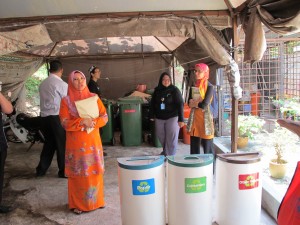 A day was spent at the University of Malaya, Kuala Lumpur Campus and ProSPER.Net participants listened to several lectures about sustainable urban development given by academics and government officials. Participants also saw practical applications of recycling and sustainability. This visit demonstrated two ways in which UM is working towards the Malaysia Vision 2020 plan.
A day was spent at the University of Malaya, Kuala Lumpur Campus and ProSPER.Net participants listened to several lectures about sustainable urban development given by academics and government officials. Participants also saw practical applications of recycling and sustainability. This visit demonstrated two ways in which UM is working towards the Malaysia Vision 2020 plan.
First, courses such as the Master of Real Estate and the Master of Architecture offer students the opportunity to learn how to design buildings that are energy efficient, use sustainable materials and have minimal environmental impact. These courses are important to produce professionals that can help meet the needs of the new urban centres that are being constructed. Students from the latter programme, based in the Faculty of Built Environment, have completed projects on green technology, utilizing materials to their maximum use, promoting aesthetics and compatibility with the surroundings. ProSPER.Net participants saw students present their ideas for the Sustainable Building Design assessment. All of the projects were impressive and showed the innovative designs used to address the environmental challenges facing urban localities.
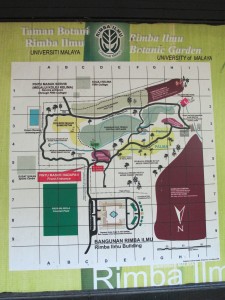 Secondly, the UM campus includes the Rimba Ilmu Botanic Gardens which is on 80 hectares of green landscape and contains over 1,600 species of tropical plants. The garden is a teaching facility and also demonstrates how development can be conducted alongside the preservation of greenery in its surroundings. The facility hosts an Environmental Education Programme (EEP) that contributes to the overall sustainability endeavors of the University. This project was initiated through the voluntary efforts of faculty members. However, the unit responsible received significant support in terms of funding and policy enforcement mechanisms.
Secondly, the UM campus includes the Rimba Ilmu Botanic Gardens which is on 80 hectares of green landscape and contains over 1,600 species of tropical plants. The garden is a teaching facility and also demonstrates how development can be conducted alongside the preservation of greenery in its surroundings. The facility hosts an Environmental Education Programme (EEP) that contributes to the overall sustainability endeavors of the University. This project was initiated through the voluntary efforts of faculty members. However, the unit responsible received significant support in terms of funding and policy enforcement mechanisms.
Promoting the value of the environment to students and staff is also manifested through several demonstration projects including:
- The Zero Waste Campaign promotes the collection and recycling of materials. For example, compost is produced using food waste generated from the UM canteens and cafes. This campaign was born out of a concern for the solid waste management problems in Malaysia. The campaign has gone beyond the borders of the university, where workshops are conducted, in collaboration with both private and governmental bodies, to replicate the developed methods.
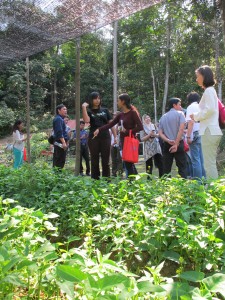 UM Crops Urban Farm, where small spaces around the campus are converted into little farms. Food waste is also used as a source of fertilization in these farms. This contributes in a large way by serving as a demonstratio
UM Crops Urban Farm, where small spaces around the campus are converted into little farms. Food waste is also used as a source of fertilization in these farms. This contributes in a large way by serving as a demonstratio
n of innovative ideas for low-cost urban agriculture which gravitates towards the desire by municipal governments to encourage such agricultural activities.- The Stream of life, which serves as a habitat for frogs, ducks and other birds and insects is also maintained by another group of students. It was inspired by the rehabilitation of waterways in Japan and Wales, showing how initiatives from other locations can be adapted to local conditions.
- Project Revival, which generated lots of machinery, personnel and resources to restore the Varsity Lake and saw the involvement of various stakeholders. This lake serves as a source of relaxation, recreation and aesthetics not just for the university, but is also open to the public. This initiative is being replicated in various parts of Malaysia where citizens are encouraged to maintain such areas in a healthy manner through the mechanism of citizen science as a tool.
These programmes could be replicated to other urban localities and are essential for healthy urban life and ecosystems. Therefore, through engagements between the university and citizens of Malaysia, these initiatives can actually become the norm in the new urban centres.
Heriot-Watt University Malaysia Campus
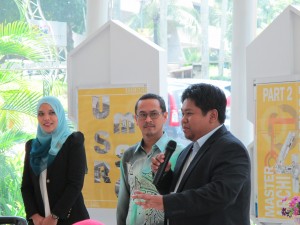 Heriot-Watt University’s Malaysia Campus is one of the most modern in Malaysia. ProSPER.Net participants were fortunate to be shown around the new building, even before the first students had arrived. The Campus is located close to the Putrajaya marina and its modern leisure and sports facilities. The setting is picturesque and beautiful, forming a fantastic green area of Putrajaya Lake’s ‘green continuum’. The new building blends into the surrounding areas and complements the neighboring buildings, but retains a distinctive identity. This is important since this university is considered the leader in Built Environment. The edifices are all eco-friendly and sustainably designed, and are characterized by high environmental standards and minimal energy use.
Heriot-Watt University’s Malaysia Campus is one of the most modern in Malaysia. ProSPER.Net participants were fortunate to be shown around the new building, even before the first students had arrived. The Campus is located close to the Putrajaya marina and its modern leisure and sports facilities. The setting is picturesque and beautiful, forming a fantastic green area of Putrajaya Lake’s ‘green continuum’. The new building blends into the surrounding areas and complements the neighboring buildings, but retains a distinctive identity. This is important since this university is considered the leader in Built Environment. The edifices are all eco-friendly and sustainably designed, and are characterized by high environmental standards and minimal energy use.
As one can see, this institution leads by example, presenting buildings that can serve as a model for the urbanization drive in Malaysia. Modern construction materials offer the opportunity to include eco-friendly and energy efficient technologies. The new urbanization drive, which is a part of the Malaysia Vision 2020 plan, could therefore see the development of “green” urban districts, which themselves can serve as positive examples to other countries in the region who face similar environmental challenges.
Concluding Remarks
This experience has demonstrated how the educational institutions can act as leaders by focusing their resources and expertise towards meeting current challenges. Sustainable development requires adaptation, innovation and flexibility, in the face of a rapidly changing world. The Malaysia experience can certainly serve as a good model for other aspiring nations and remind us of the inevitable need for a vibrant educational sector that works collaboratively with the government, other stakeholders and the wider community.
